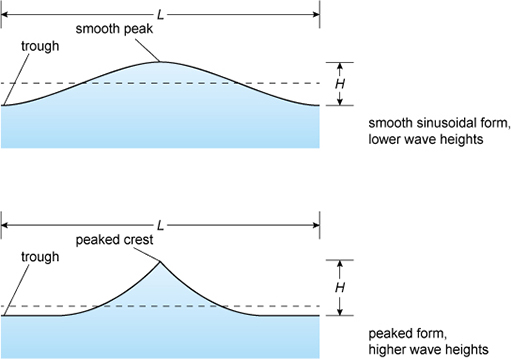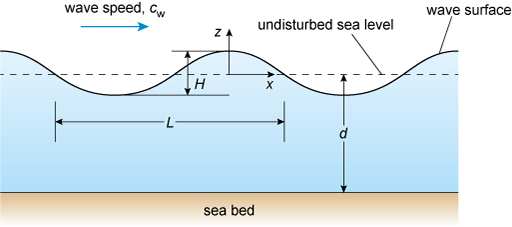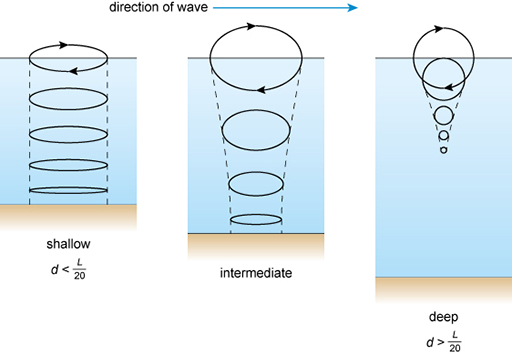2.2 Wave speed, amplitude and displacement
The interaction of a wind over the surface of water to produce waves is complex. On the surface of deep water the wave speed of typical waves can be modelled as
where is the wavelength from peak to peak between two waves following each other and is the acceleration due to gravity. The peak is the highest point of the wave, and is also known as the crest. Thus the wave speed is greater for longer wavelengths. Consequently a swell may comprise long and fast waves, which can also be very high if the initiating wind speed itself is both high and sustained for a significant time. The height, , of a wave is taken to be the distance from the lowest level of the surface to the top of the wave. The lowest level is called the trough. The shape of a wave – its cross section or side view – depends upon its height and wavelength. At lower heights, it tends to be sinusoidal, so the amplitude of this type of wave will be half the height from trough to crest.
Wave speeds
The action of wind over deep water is to create a disturbance on the surface layers of the water. This disturbance takes the form of a wave which travels more or less in the same direction as the wind but at a speed which is given by
where is the wave speed, is the wavelength and is the acceleration due to gravity.
Note that the wave is a disturbance which moves along and through the water – the water itself does not move along, except in the case of a tsunami.
Higher waves tend to have a narrower crest and a wider and shallower trough, as sketched in Figure 12.
At a value of the crests become more pronounced and sharp-edged in profile and the top edges break into foaming white water (white horses). This foaming dissipates energy, which effectively stops further growth in height, meaning that the ratio stays at a maximum value of .
The breaking of waves is of course most evident in shallow water at the beach. Once the depth of water has reduced to about , the shape of the wave profile alters again. If the slope of the beach is small (e.g. less than about 1 in 30 or 3.3%) the wave will break progressively as it rolls in, and the water itself does travel along in this case. If the slope is much greater, the wave is effectively slowed down and cannot adjust; instead, it becomes unstable, growing in height and then breaking by plunging over in a dramatic fashion. This still contains a lot of energy and can impart high forces on anything in its path. Even a non-breaking wave can cause large forces owing to the energy it contains, as the speed causes drag forces on anything it flows past.
A typical wave can be modelled quite easily. Figure 13 shows a wave of sinusoidal form with a relatively small surface displacement amplitude in comparison to the wavelength and depth of the water. The sea bed is assumed to be flat and smooth (with negligible friction), and there is a steady series of waves flowing to the right with speed . The wave depth is , which in this model will be twice the amplitude. The wave periodic time, , is the time taken for one complete wavelength to pass through and is given by
As mentioned above, each water particle will move in an approximately circular orbit as the wave disturbance passes through. Figure 14 shows the shapes of an individual water particle orbits for shallow, intermediate depth and deep water in schematic form; the relative sizes are not to scale. In shallow water, the orbit is elliptical in cross section and reaches to the sea bed. In the intermediate depth, the orbit is more circular, and in deep water the orbit is completely circular and does not extend to the sea bed.
Generally at a water depth equivalent to half the wave length, , the amplitude of wave motion is barely 4% of that at the surface. This forms a useful rule of thumb in defining a ‘deep water’ wave. Assuming a deep water situation, the wave motion of an individual particle of water as a wave passes is near enough circular. Taking a stationary reference axis set at the flat sea level, as the depth increases with , the wave motion amplitude reduces by a factor of , where numerically will be negative.
In other words, if is the surface amplitude and is the amplitude at depth (where is a negative number) then
If the radius of the circular motion is , the particle speed will be given by (as with any circular motion), and its acceleration will be
where is the radian circular frequency. Again, as with all circular orbiting motion
and
which is a rearranged version of Equation 13.
Deep water wave study
For a wave in deep water of wavelength 200.0 m and height 6.0 m, calculate:
- a.the wave speed
- b.the periodic time
- c.the displacement amplitude at the surface
- d.the displacement amplitude at 50.0 m depth
- e.the maximum horizontal acceleration at 25.0 m depth.
Give your answers to 3 significant figures.
Solution
a.Using Equation 12:
b.Using Equation 13;
c.The amplitude at the surface is
d.To find the displacement amplitude, Equation 14 is used:
First calculate the factor at 50 m depth:
This gives a displacement amplitude
e.First calculate the displacement amplitude at 25 m depth, since this is also the radius of the particle’s circular motion:
so the radius of circular motion (or displacement amplitude) is
Now, using Equation 16:
Therefore, from Equation 15, the acceleration amplitude is
Activity 1
The wave as described above has decayed such that its height is reduced by 50%. Determine the same parameters, noting the changes in values:
- a.the wave speed
- b.the periodic time
- c.the displacement amplitude at the surface
- d.the displacement amplitude at 50.0 m depth
- e.the maximum horizontal acceleration at 25.0 m depth.
Give your answers to 3 significant figures.
Answer
a.Using Equation 12,
The value is the same.
b.Using Equation 13,
The value is the same.
c.The amplitude at the surface is
The surface amplitude has reduced by 50%.
d.To find the displacement amplitude Equation 14 is used:
The factor at 50 m depth will be the same:
This gives a displacement amplitude of
This shows a reduction of 50%.
e.First calculate the displacement amplitude at 25 m depth, since this is also the radius of the particle’s circular motion. The factor will be the same at
The radius of circular motion (or displacement amplitude) is
This is a reduction of 50%. Now, using Equation 16, angular velocity will be the same at
The acceleration amplitude is
This is a reduction of 50%.
Wave models
For typical wind-provoked waves over deep water the following relationships can be used to model the wave properties:
The speed of the wave is
where is the wavelength and is the acceleration due to gravity.
The periodic time for one complete wave to pass by is
and the wavelength in terms of velocity and periodic time is .
The frequency of the waves in relation to the periodic time is
where is the radian circular frequency and is the frequency in Hertz or cycles per second.
At a depth (a negative numerical value) the amplitude of a wave is
where is the amplitude at the surface.



